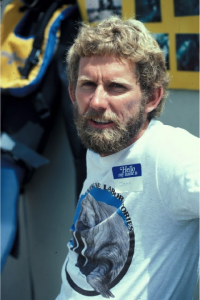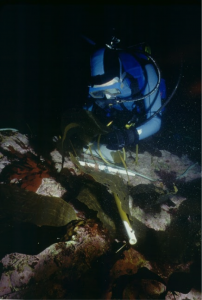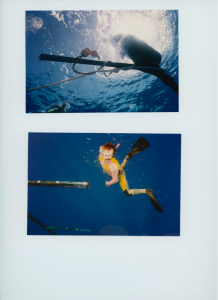By John Heine (17 December 2015)
I came to MLML as a graduate student in the Fall of 1979. The first semester there I took the Marine Science Diving course taught by Gary Ichikawa and Bob vanWagenen, both graduate students. The next summer the lab sent me to a NAUI Instructor Training course at SDSU, and I took over teaching the Marine Science Diving class after that.

The Diving Safety Officer duties at the lab during this time were shared by Drs. Michael Foster and Ann Hurley. I became appointed to that position on a part-time basis in 1982, after I finished my master’s degree, and became full-time in 1985. There is a long list of teaching assistants that co-taught the scientific diving course with me during the “middle years”. These include Guy Hoelzer, Don Canestro, Sean Wheelock, Marc Slattery, Jim Weston, Peter vonLangen, Nicole Crane, Clare Dominick, Diana Steller, Matt Edwards, and Jason Felton (apologies to those not listed!). There is also a long legacy of graduate students who used scientific diving for their theses. Many have gone on to successful careers in academia, government, and private industry.
One of the earliest projects that I became involved with was one that Mike Foster had with a grant from the California Department of Fish and Game to study the potential effects of sea otter foraging to the north of their current range at the time, which was roughly Monterey Bay. Mike asked me to head up the field component, which meant assembling an eight person dive team to do the subtidal sampling between Santa Cruz and Ano Nuevo. This might be a little more difficult to attempt these days with the increased populations of white sharks in the area!
We left Moss Landing Harbor very early in the morning aboard the R/V Ed Ricketts, captained by Mark Carr. We would usually do two or three dives to a depth of 60 feet, doing transects to count invertebrates or doing random point contact quadrats to estimate the percent cover of the algae. The US Navy decompression tables served us well, and there were no shark attacks. Also, skipper Mark Carr kept us entertained using the underwater speaker/diver recall to play KPIG!
There were a number of other projects that used the diving program during these middle years. Some that come to mind include MOBY in Monterey Bay and Hawaii, VERTEX, the Benthic Lab cruises in the Arctic, various NURP projects at Catalina Island and the Big Sur coast, projects in Antarctica with Jim McClintock and the Benthic Lab with John Oliver and Stacy Kim, NURP-funded rockfish tagging and tracking with Rick Starr, and many graduate student projects around the globe.

I did many cruises with the MOBY group in Hawaii, installing and retrieving the large optical instrument, and conducting calibrations on the light collectors (see Fig. 3). We had a lot of fun and saw some interesting creatures underwater, including mahi mahi, a pilot whale, and white-tip sharks that scared an unnamed diver from the Physical Oceanography lab clear out of the water!

During my tenure there at MLML the diving program improved with the acquisition of many new small boats, a new compressor and nitrox blending system (thanks to a facilities grant from the NSF), underwater imaging systems, and improved collaborations with local researchers. I left the labs in 2002 to pursue other opportunities, and the diving program was left in the capable hands of Dr. Diana Steller, whose blog on the “recent years” will be appearing soon.
Happy 50th Anniversary to MLML, who anyone that has ever been involved there, whether student, staff, or faculty, knows what a great institution it truly is!

